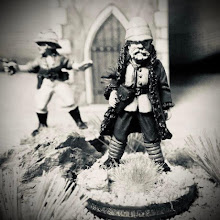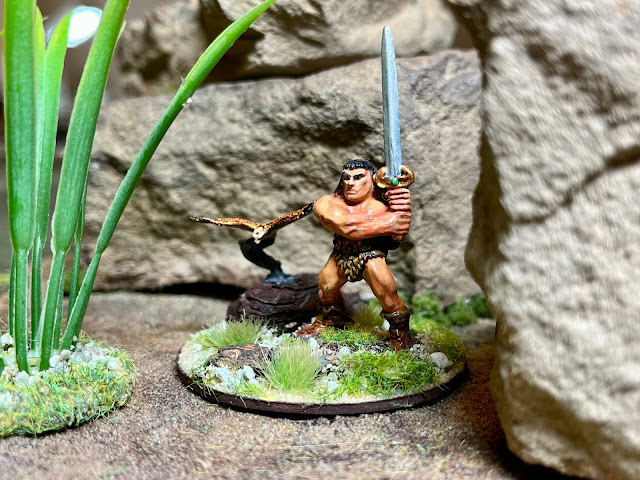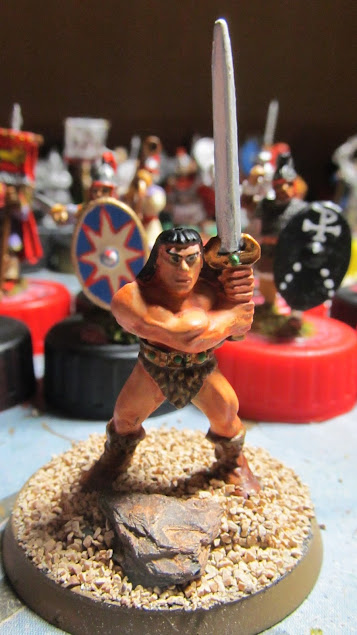No Victory Points in this battle. If the Indian Army gets Billy the Mule to Camp Bailey, they win. If the ammunition doesn't make it, Mr. Babbage wins.
Most young boys (and some adventurous girls) play with Toy Soldiers; some never stop! I'm proud to say that I am one that never has stopped. Toy Soldiers, painting the figures, history and miniature wargaming is what this site is all about. May the God who gives encouragement give you the same attitude of mind toward each other that Christ Jesus had, so that with one mind and one voice you may glorify the God and Father of our Lord Jesus Christ.
As an Amazon Associate I earn from qualifying purchases
Tuesday, September 27, 2022
"I will call him . . . Mini-Mr. Babagge
No Victory Points in this battle. If the Indian Army gets Billy the Mule to Camp Bailey, they win. If the ammunition doesn't make it, Mr. Babbage wins.
 I'm a retired Colonel of Infantry (Regulars by God!) and Military Historian who likes to play with toy soldiers. I've been married to the love of my life since 1986, I have 5 honorable sons (my geeks in training), 4 daughters-in-law, a beautiful grandson, 1 dog and a gazillion miniatures.
Hobbies include . . . wait for it . . . Toy Soldiers, Reading, Wargaming, Reading about Toy Soldiers, History, Reading about Wargaming, Gardening, Reading about History and Reading.
I'm a retired Colonel of Infantry (Regulars by God!) and Military Historian who likes to play with toy soldiers. I've been married to the love of my life since 1986, I have 5 honorable sons (my geeks in training), 4 daughters-in-law, a beautiful grandson, 1 dog and a gazillion miniatures.
Hobbies include . . . wait for it . . . Toy Soldiers, Reading, Wargaming, Reading about Toy Soldiers, History, Reading about Wargaming, Gardening, Reading about History and Reading.
Friday, September 16, 2022
“Hither came Conan, the Cimmerian, . . . and he needed a bigger base."
 “Hither came Conan, the Cimmerian, black-haired, sullen-eyed, sword in hand, a thief, a reaver, a slayer, with gigantic melancholies and gigantic mirth, to tread the jeweled thrones of the Earth under his sandaled feet.”
“Hither came Conan, the Cimmerian, black-haired, sullen-eyed, sword in hand, a thief, a reaver, a slayer, with gigantic melancholies and gigantic mirth, to tread the jeweled thrones of the Earth under his sandaled feet.” I'm a retired Colonel of Infantry (Regulars by God!) and Military Historian who likes to play with toy soldiers. I've been married to the love of my life since 1986, I have 5 honorable sons (my geeks in training), 4 daughters-in-law, a beautiful grandson, 1 dog and a gazillion miniatures.
Hobbies include . . . wait for it . . . Toy Soldiers, Reading, Wargaming, Reading about Toy Soldiers, History, Reading about Wargaming, Gardening, Reading about History and Reading.
I'm a retired Colonel of Infantry (Regulars by God!) and Military Historian who likes to play with toy soldiers. I've been married to the love of my life since 1986, I have 5 honorable sons (my geeks in training), 4 daughters-in-law, a beautiful grandson, 1 dog and a gazillion miniatures.
Hobbies include . . . wait for it . . . Toy Soldiers, Reading, Wargaming, Reading about Toy Soldiers, History, Reading about Wargaming, Gardening, Reading about History and Reading.
Tuesday, September 13, 2022
20th (Duke of Cambridge's Own) (Punjab) Regiment of Bengal Native Infantry
Next unit up for my Indian Army for The Men Who Would be Kings is the 20th (Punjab) Regiment with all figures from Artizan Designs (UK/EU link and US Link). I feel I have my "speed painting" method down using GW Skeleton Horde Contrast for the khaki uniforms. As you can see above, for this unit I went with the alternative basing of "3", "2", "1". Of course they can be used for other popular Colonial rules.
The regiment was raised at Nowshera on 1 August 1857 by Lieutenant Charles Henry Brownlow from drafts provided by 4th and 5th Punjab Infantry on the orders of John Lawrence, the British High Commissioner of the Punjab. It was one of several battalions raised by Lawrence to suppress the Great Indian Mutiny of 1857. Brownlow, who became their first commanding officer, remained associated with the regiment for more than half a century; becoming their Honorary Colonel in 1904. He was made a Field Marshal in 1908.
The regiment's first overseas service came during the Second Opium War against China. Soon after landing there, it took part in the successful assault on Taku Forts on 21 August 1860. The regiment then advanced with the rest of the British force, arriving at Peking (Beijing) in late September, which was captured on 6 October. In 1861, the regiment was brought into the line as the 24th Regiment of Bengal Native Infantry, replacing the previous 24th which had mutinied in 1857. It was renumbered as the 20th Regiment later in the year.
In 1863, it took part in the Umbeyla Campaign on the North-West Frontier of India. During the fierce fighting at Crag Picquet in October and November, the 20th Punjabis retook the position, which had been captured by the tribesmen on 30 October. It then successfully defended the post from repeated attacks by the tribal forces. It was the first of many such engagements against the hostile Pashtun tribes of the Afghan frontier. In 1864, the regiment, now designated as the 20th (Punjab) Regiment of Bengal Native Infantry, took part in the Black Mountain Expedition, and in 1877, it operated against the Jowaki Afridis.
In 1891, after the Mir of Hunza refused to guarantee safe Btitish passage through his state, the 20th Punjabis participated in Colonel Algernon Durand's expedition to Hunza. In 1897, during a general uprising of Pashtun tribes, the regiment operated as part of the Mohmand Field Force. The regiment, under the command by Lieutenant-Colonel (later Lieutenant-General) JB Woon, fought in a fierce engagement against a force of about 6,000 Mohmands at Shabkadr. In 1900, the 20th Punjabis were sent to China to suppress the Boxer Rebellion.
Subsequent to the reforms brought about in the Indian Army by Lord Kitchener, the regiment's designation was changed to 20th Duke of Cambridge's Own Punjabis in 1903, and then 20th Duke of Cambridge's Own Infantry (Brownlow's Punjabis) in 1904.
 I'm a retired Colonel of Infantry (Regulars by God!) and Military Historian who likes to play with toy soldiers. I've been married to the love of my life since 1986, I have 5 honorable sons (my geeks in training), 4 daughters-in-law, a beautiful grandson, 1 dog and a gazillion miniatures.
Hobbies include . . . wait for it . . . Toy Soldiers, Reading, Wargaming, Reading about Toy Soldiers, History, Reading about Wargaming, Gardening, Reading about History and Reading.
I'm a retired Colonel of Infantry (Regulars by God!) and Military Historian who likes to play with toy soldiers. I've been married to the love of my life since 1986, I have 5 honorable sons (my geeks in training), 4 daughters-in-law, a beautiful grandson, 1 dog and a gazillion miniatures.
Hobbies include . . . wait for it . . . Toy Soldiers, Reading, Wargaming, Reading about Toy Soldiers, History, Reading about Wargaming, Gardening, Reading about History and Reading.
Saturday, September 10, 2022
The Passing of an Age
 I'm a retired Colonel of Infantry (Regulars by God!) and Military Historian who likes to play with toy soldiers. I've been married to the love of my life since 1986, I have 5 honorable sons (my geeks in training), 4 daughters-in-law, a beautiful grandson, 1 dog and a gazillion miniatures.
Hobbies include . . . wait for it . . . Toy Soldiers, Reading, Wargaming, Reading about Toy Soldiers, History, Reading about Wargaming, Gardening, Reading about History and Reading.
I'm a retired Colonel of Infantry (Regulars by God!) and Military Historian who likes to play with toy soldiers. I've been married to the love of my life since 1986, I have 5 honorable sons (my geeks in training), 4 daughters-in-law, a beautiful grandson, 1 dog and a gazillion miniatures.
Hobbies include . . . wait for it . . . Toy Soldiers, Reading, Wargaming, Reading about Toy Soldiers, History, Reading about Wargaming, Gardening, Reading about History and Reading.
Tuesday, September 6, 2022
Characters from the Novel "Kim": Teshoo Lama
― Rudyard Kipling, Kim
Since I had already converted figures for Kim and Mahbub Ali - how could I not do a figure for a character that spends more time with him and influences him in the novel. I'm not going to cover those details - I want you to read what I consider Kipling's best novel. So here we go:
Okay, that looks like crap and the head looks even smaller. The lesson learned (you would think I would know by now) don't start painting until you know what you want. On a positive note, I used some of the same type of bits to add character to the figure that I did with Kim; pouches from Gripping Beasts Viking Hirdmen, household string for a strap, and a blanket role from Games Workshop's Empire (or whatever they are called now) Pistoliers.
Wow. Looks like a turtle neck from the back. I'm sad to say, the figure is now scheduled for beheading and I hoped that I would not make too much of a mess of it to salvage the figure.
Fortunately the scheduled procedure went well. I used an extra head from the Perry Miniatures Afghan Tribesmen box, carefully cut off the turban and trimmed the mustache, and then added a new (the other one was damaged removing it from the wizard's head) straw hat from the ECW box. Ta dah! Yes, you can see that I did not carefully wash the glue on my fingers. I had to go back with a moist clothe to remove the glue and not the paint.
Points: 46
 I'm a retired Colonel of Infantry (Regulars by God!) and Military Historian who likes to play with toy soldiers. I've been married to the love of my life since 1986, I have 5 honorable sons (my geeks in training), 4 daughters-in-law, a beautiful grandson, 1 dog and a gazillion miniatures.
Hobbies include . . . wait for it . . . Toy Soldiers, Reading, Wargaming, Reading about Toy Soldiers, History, Reading about Wargaming, Gardening, Reading about History and Reading.
I'm a retired Colonel of Infantry (Regulars by God!) and Military Historian who likes to play with toy soldiers. I've been married to the love of my life since 1986, I have 5 honorable sons (my geeks in training), 4 daughters-in-law, a beautiful grandson, 1 dog and a gazillion miniatures.
Hobbies include . . . wait for it . . . Toy Soldiers, Reading, Wargaming, Reading about Toy Soldiers, History, Reading about Wargaming, Gardening, Reading about History and Reading.
























_Bengal_Infantry_(6_Punjab),_Egypt_1882_2.jpg)











